Comprehensive Analysis of Public Health Study Designs
VerifiedAdded on 2022/11/15
|9
|2387
|397
Homework Assignment
AI Summary
This assignment provides an analysis of various study designs used in public health research. Part 1 examines the Whitehall studies, including their sampling frames and generalizability. It also explores the methods used in studies by Chandola et al. (2008), Breeze et al. (2001), and Marmot et al. (1978), discussing their advantages and limitations. Finally, it suggests existing Australian cohorts for conducting similar research. Part 2 focuses on specific study designs, including case-control, meta-analysis, cross-sectional, and cohort studies, and their applications in addressing research questions related to lung cancer, depression, detention of asylum seekers, folate supplementation and autism, and drug testing for Alzheimer's disease. Each section evaluates the advantages, disadvantages, and ethical considerations of each design, providing a comprehensive overview of research methodologies in public health.

Running head: STUDY DESIGN
STUDY DESIGN
Name of Student:
Name of University:
Author’s Note:
STUDY DESIGN
Name of Student:
Name of University:
Author’s Note:
Paraphrase This Document
Need a fresh take? Get an instant paraphrase of this document with our AI Paraphraser
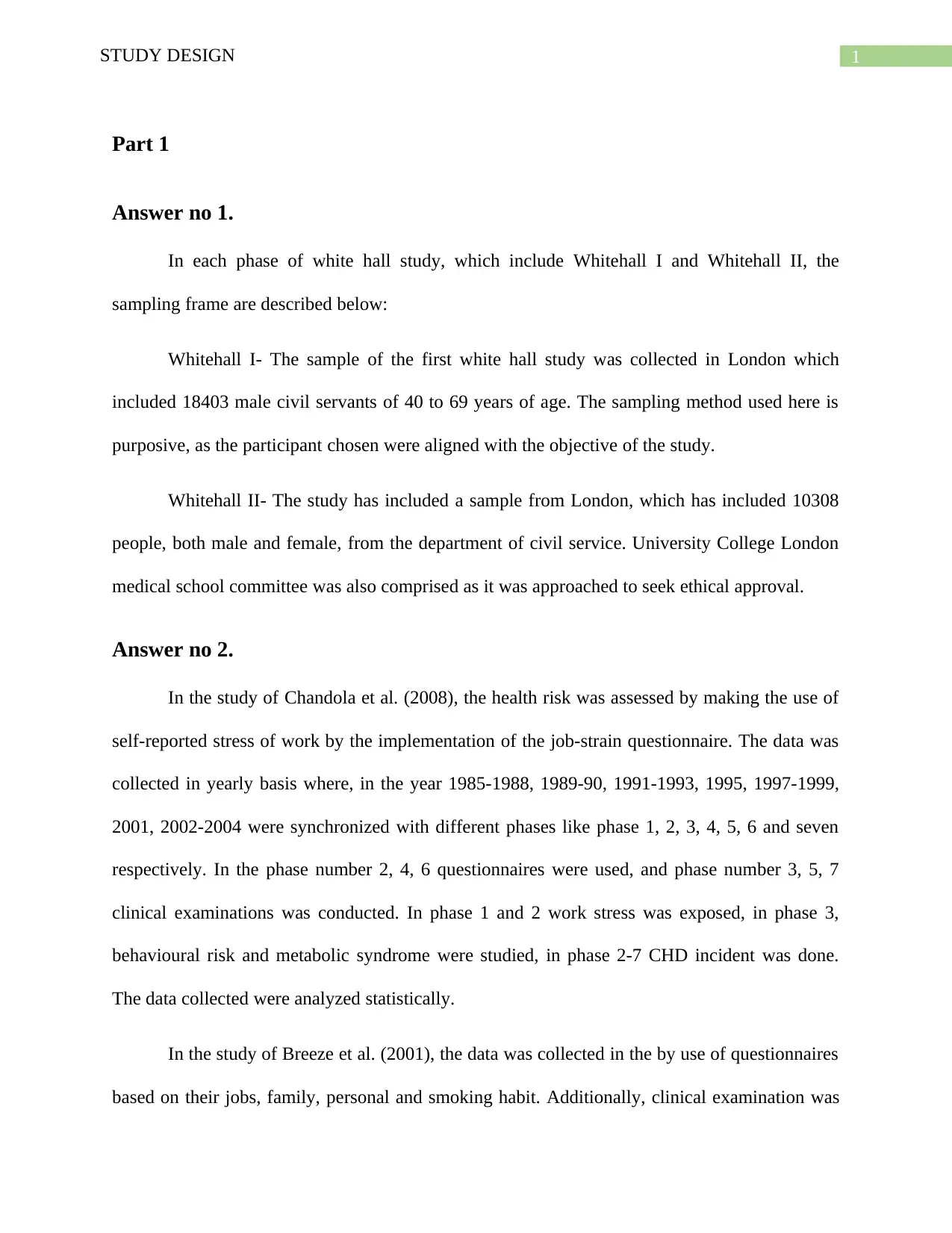
1STUDY DESIGN
Part 1
Answer no 1.
In each phase of white hall study, which include Whitehall I and Whitehall II, the
sampling frame are described below:
Whitehall I- The sample of the first white hall study was collected in London which
included 18403 male civil servants of 40 to 69 years of age. The sampling method used here is
purposive, as the participant chosen were aligned with the objective of the study.
Whitehall II- The study has included a sample from London, which has included 10308
people, both male and female, from the department of civil service. University College London
medical school committee was also comprised as it was approached to seek ethical approval.
Answer no 2.
In the study of Chandola et al. (2008), the health risk was assessed by making the use of
self-reported stress of work by the implementation of the job-strain questionnaire. The data was
collected in yearly basis where, in the year 1985-1988, 1989-90, 1991-1993, 1995, 1997-1999,
2001, 2002-2004 were synchronized with different phases like phase 1, 2, 3, 4, 5, 6 and seven
respectively. In the phase number 2, 4, 6 questionnaires were used, and phase number 3, 5, 7
clinical examinations was conducted. In phase 1 and 2 work stress was exposed, in phase 3,
behavioural risk and metabolic syndrome were studied, in phase 2-7 CHD incident was done.
The data collected were analyzed statistically.
In the study of Breeze et al. (2001), the data was collected in the by use of questionnaires
based on their jobs, family, personal and smoking habit. Additionally, clinical examination was
Part 1
Answer no 1.
In each phase of white hall study, which include Whitehall I and Whitehall II, the
sampling frame are described below:
Whitehall I- The sample of the first white hall study was collected in London which
included 18403 male civil servants of 40 to 69 years of age. The sampling method used here is
purposive, as the participant chosen were aligned with the objective of the study.
Whitehall II- The study has included a sample from London, which has included 10308
people, both male and female, from the department of civil service. University College London
medical school committee was also comprised as it was approached to seek ethical approval.
Answer no 2.
In the study of Chandola et al. (2008), the health risk was assessed by making the use of
self-reported stress of work by the implementation of the job-strain questionnaire. The data was
collected in yearly basis where, in the year 1985-1988, 1989-90, 1991-1993, 1995, 1997-1999,
2001, 2002-2004 were synchronized with different phases like phase 1, 2, 3, 4, 5, 6 and seven
respectively. In the phase number 2, 4, 6 questionnaires were used, and phase number 3, 5, 7
clinical examinations was conducted. In phase 1 and 2 work stress was exposed, in phase 3,
behavioural risk and metabolic syndrome were studied, in phase 2-7 CHD incident was done.
The data collected were analyzed statistically.
In the study of Breeze et al. (2001), the data was collected in the by use of questionnaires
based on their jobs, family, personal and smoking habit. Additionally, clinical examination was
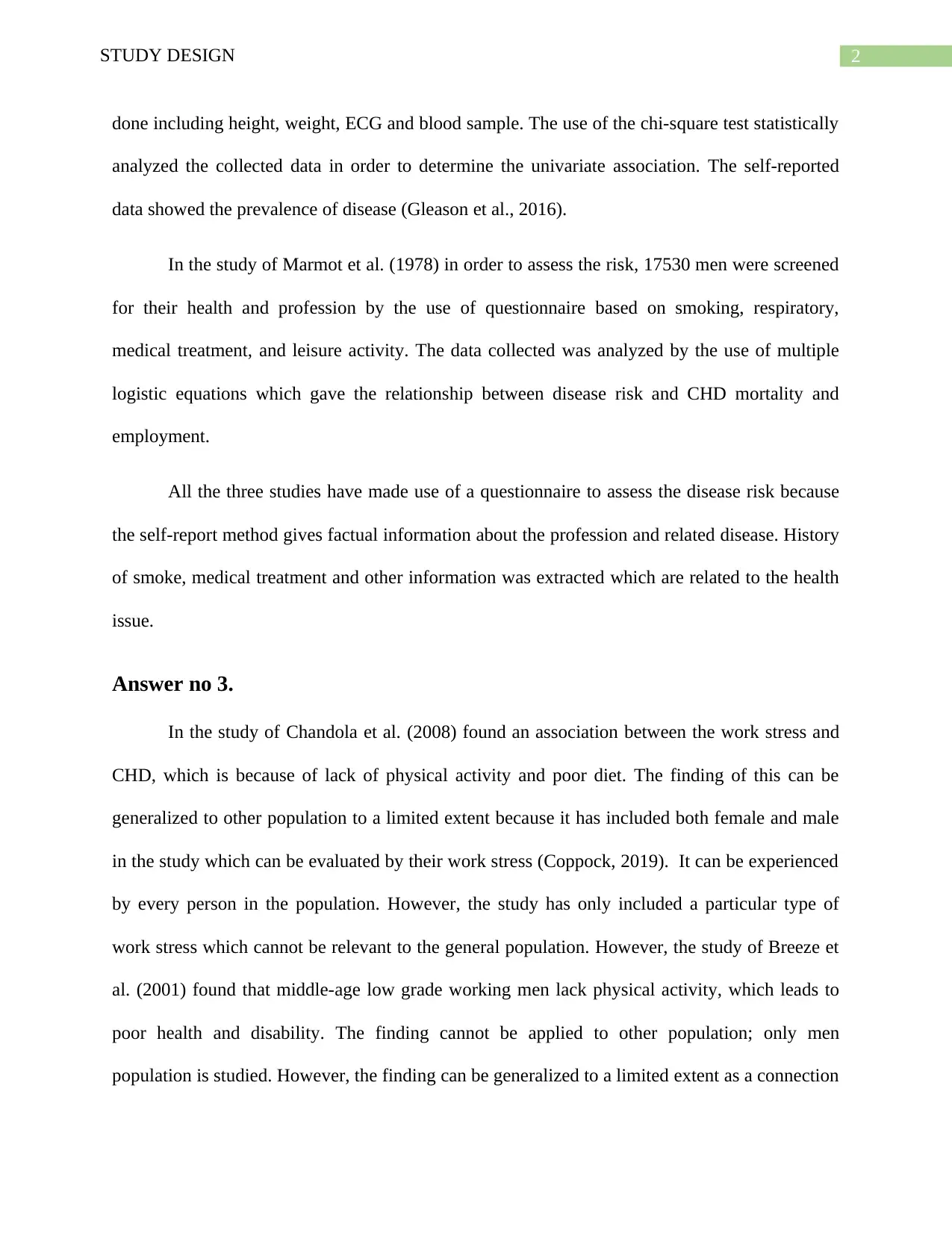
2STUDY DESIGN
done including height, weight, ECG and blood sample. The use of the chi-square test statistically
analyzed the collected data in order to determine the univariate association. The self-reported
data showed the prevalence of disease (Gleason et al., 2016).
In the study of Marmot et al. (1978) in order to assess the risk, 17530 men were screened
for their health and profession by the use of questionnaire based on smoking, respiratory,
medical treatment, and leisure activity. The data collected was analyzed by the use of multiple
logistic equations which gave the relationship between disease risk and CHD mortality and
employment.
All the three studies have made use of a questionnaire to assess the disease risk because
the self-report method gives factual information about the profession and related disease. History
of smoke, medical treatment and other information was extracted which are related to the health
issue.
Answer no 3.
In the study of Chandola et al. (2008) found an association between the work stress and
CHD, which is because of lack of physical activity and poor diet. The finding of this can be
generalized to other population to a limited extent because it has included both female and male
in the study which can be evaluated by their work stress (Coppock, 2019). It can be experienced
by every person in the population. However, the study has only included a particular type of
work stress which cannot be relevant to the general population. However, the study of Breeze et
al. (2001) found that middle-age low grade working men lack physical activity, which leads to
poor health and disability. The finding cannot be applied to other population; only men
population is studied. However, the finding can be generalized to a limited extent as a connection
done including height, weight, ECG and blood sample. The use of the chi-square test statistically
analyzed the collected data in order to determine the univariate association. The self-reported
data showed the prevalence of disease (Gleason et al., 2016).
In the study of Marmot et al. (1978) in order to assess the risk, 17530 men were screened
for their health and profession by the use of questionnaire based on smoking, respiratory,
medical treatment, and leisure activity. The data collected was analyzed by the use of multiple
logistic equations which gave the relationship between disease risk and CHD mortality and
employment.
All the three studies have made use of a questionnaire to assess the disease risk because
the self-report method gives factual information about the profession and related disease. History
of smoke, medical treatment and other information was extracted which are related to the health
issue.
Answer no 3.
In the study of Chandola et al. (2008) found an association between the work stress and
CHD, which is because of lack of physical activity and poor diet. The finding of this can be
generalized to other population to a limited extent because it has included both female and male
in the study which can be evaluated by their work stress (Coppock, 2019). It can be experienced
by every person in the population. However, the study has only included a particular type of
work stress which cannot be relevant to the general population. However, the study of Breeze et
al. (2001) found that middle-age low grade working men lack physical activity, which leads to
poor health and disability. The finding cannot be applied to other population; only men
population is studied. However, the finding can be generalized to a limited extent as a connection
⊘ This is a preview!⊘
Do you want full access?
Subscribe today to unlock all pages.

Trusted by 1+ million students worldwide
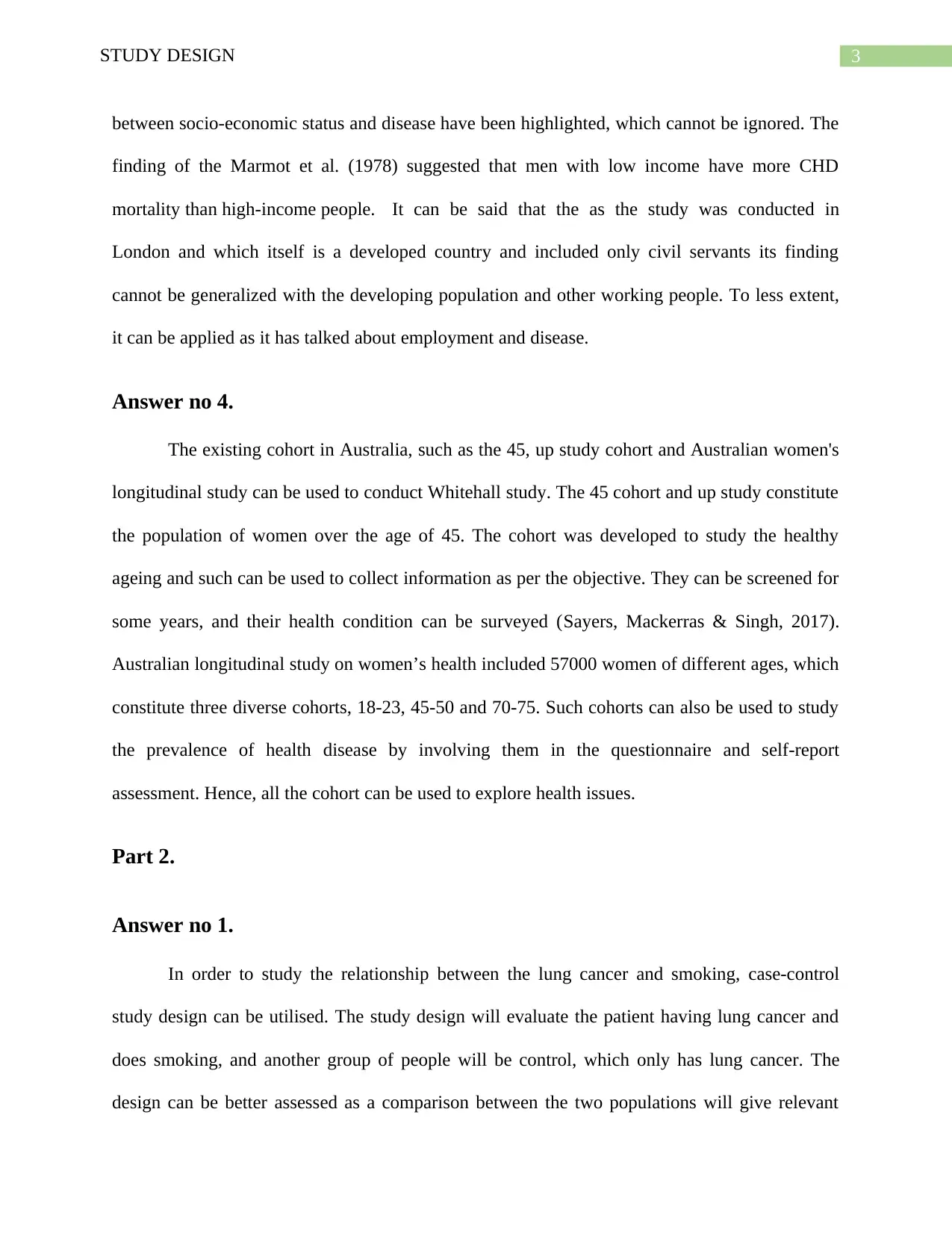
3STUDY DESIGN
between socio-economic status and disease have been highlighted, which cannot be ignored. The
finding of the Marmot et al. (1978) suggested that men with low income have more CHD
mortality than high-income people. It can be said that the as the study was conducted in
London and which itself is a developed country and included only civil servants its finding
cannot be generalized with the developing population and other working people. To less extent,
it can be applied as it has talked about employment and disease.
Answer no 4.
The existing cohort in Australia, such as the 45, up study cohort and Australian women's
longitudinal study can be used to conduct Whitehall study. The 45 cohort and up study constitute
the population of women over the age of 45. The cohort was developed to study the healthy
ageing and such can be used to collect information as per the objective. They can be screened for
some years, and their health condition can be surveyed (Sayers, Mackerras & Singh, 2017).
Australian longitudinal study on women’s health included 57000 women of different ages, which
constitute three diverse cohorts, 18-23, 45-50 and 70-75. Such cohorts can also be used to study
the prevalence of health disease by involving them in the questionnaire and self-report
assessment. Hence, all the cohort can be used to explore health issues.
Part 2.
Answer no 1.
In order to study the relationship between the lung cancer and smoking, case-control
study design can be utilised. The study design will evaluate the patient having lung cancer and
does smoking, and another group of people will be control, which only has lung cancer. The
design can be better assessed as a comparison between the two populations will give relevant
between socio-economic status and disease have been highlighted, which cannot be ignored. The
finding of the Marmot et al. (1978) suggested that men with low income have more CHD
mortality than high-income people. It can be said that the as the study was conducted in
London and which itself is a developed country and included only civil servants its finding
cannot be generalized with the developing population and other working people. To less extent,
it can be applied as it has talked about employment and disease.
Answer no 4.
The existing cohort in Australia, such as the 45, up study cohort and Australian women's
longitudinal study can be used to conduct Whitehall study. The 45 cohort and up study constitute
the population of women over the age of 45. The cohort was developed to study the healthy
ageing and such can be used to collect information as per the objective. They can be screened for
some years, and their health condition can be surveyed (Sayers, Mackerras & Singh, 2017).
Australian longitudinal study on women’s health included 57000 women of different ages, which
constitute three diverse cohorts, 18-23, 45-50 and 70-75. Such cohorts can also be used to study
the prevalence of health disease by involving them in the questionnaire and self-report
assessment. Hence, all the cohort can be used to explore health issues.
Part 2.
Answer no 1.
In order to study the relationship between the lung cancer and smoking, case-control
study design can be utilised. The study design will evaluate the patient having lung cancer and
does smoking, and another group of people will be control, which only has lung cancer. The
design can be better assessed as a comparison between the two populations will give relevant
Paraphrase This Document
Need a fresh take? Get an instant paraphrase of this document with our AI Paraphraser
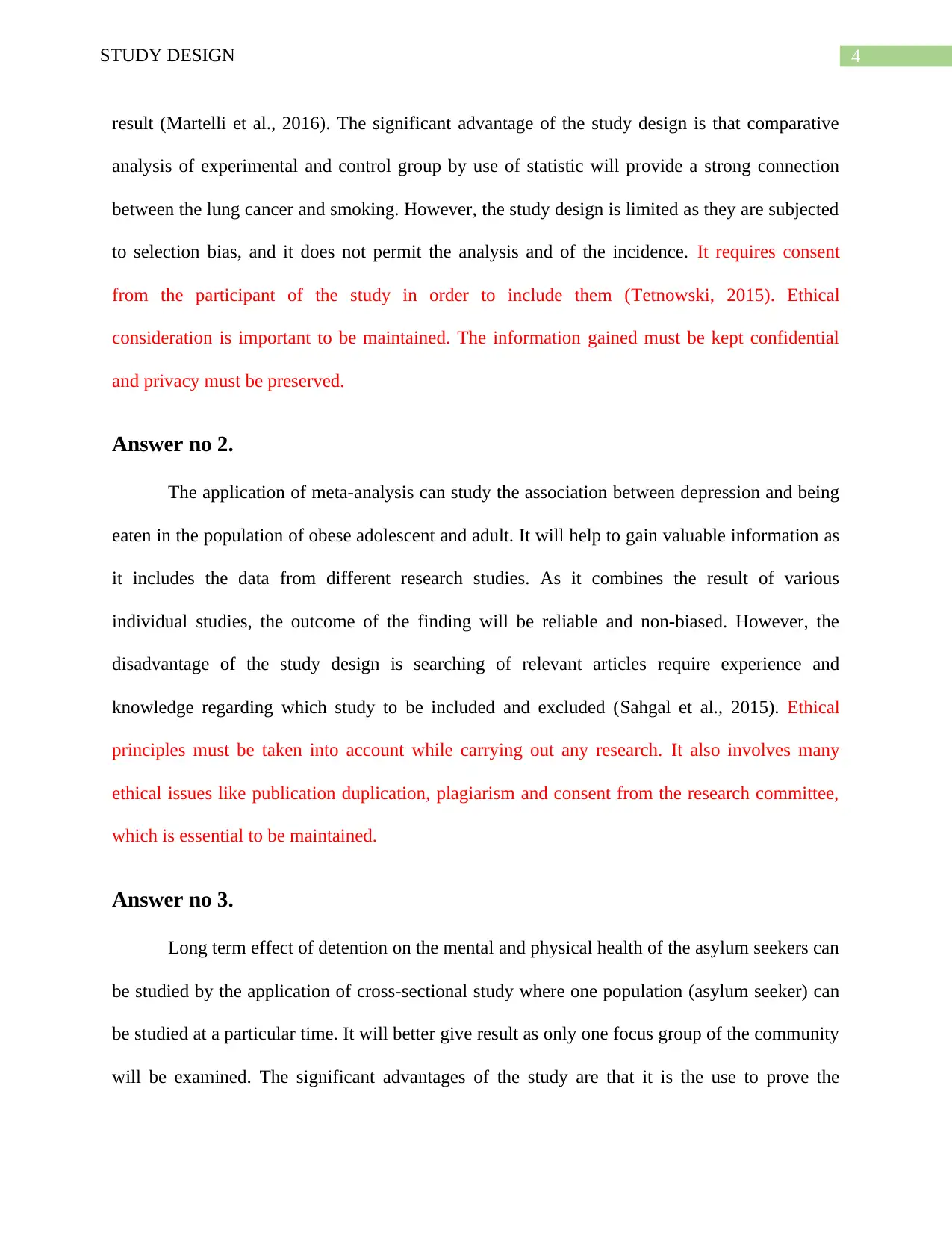
4STUDY DESIGN
result (Martelli et al., 2016). The significant advantage of the study design is that comparative
analysis of experimental and control group by use of statistic will provide a strong connection
between the lung cancer and smoking. However, the study design is limited as they are subjected
to selection bias, and it does not permit the analysis and of the incidence. It requires consent
from the participant of the study in order to include them (Tetnowski, 2015). Ethical
consideration is important to be maintained. The information gained must be kept confidential
and privacy must be preserved.
Answer no 2.
The application of meta-analysis can study the association between depression and being
eaten in the population of obese adolescent and adult. It will help to gain valuable information as
it includes the data from different research studies. As it combines the result of various
individual studies, the outcome of the finding will be reliable and non-biased. However, the
disadvantage of the study design is searching of relevant articles require experience and
knowledge regarding which study to be included and excluded (Sahgal et al., 2015). Ethical
principles must be taken into account while carrying out any research. It also involves many
ethical issues like publication duplication, plagiarism and consent from the research committee,
which is essential to be maintained.
Answer no 3.
Long term effect of detention on the mental and physical health of the asylum seekers can
be studied by the application of cross-sectional study where one population (asylum seeker) can
be studied at a particular time. It will better give result as only one focus group of the community
will be examined. The significant advantages of the study are that it is the use to prove the
result (Martelli et al., 2016). The significant advantage of the study design is that comparative
analysis of experimental and control group by use of statistic will provide a strong connection
between the lung cancer and smoking. However, the study design is limited as they are subjected
to selection bias, and it does not permit the analysis and of the incidence. It requires consent
from the participant of the study in order to include them (Tetnowski, 2015). Ethical
consideration is important to be maintained. The information gained must be kept confidential
and privacy must be preserved.
Answer no 2.
The application of meta-analysis can study the association between depression and being
eaten in the population of obese adolescent and adult. It will help to gain valuable information as
it includes the data from different research studies. As it combines the result of various
individual studies, the outcome of the finding will be reliable and non-biased. However, the
disadvantage of the study design is searching of relevant articles require experience and
knowledge regarding which study to be included and excluded (Sahgal et al., 2015). Ethical
principles must be taken into account while carrying out any research. It also involves many
ethical issues like publication duplication, plagiarism and consent from the research committee,
which is essential to be maintained.
Answer no 3.
Long term effect of detention on the mental and physical health of the asylum seekers can
be studied by the application of cross-sectional study where one population (asylum seeker) can
be studied at a particular time. It will better give result as only one focus group of the community
will be examined. The significant advantages of the study are that it is the use to prove the
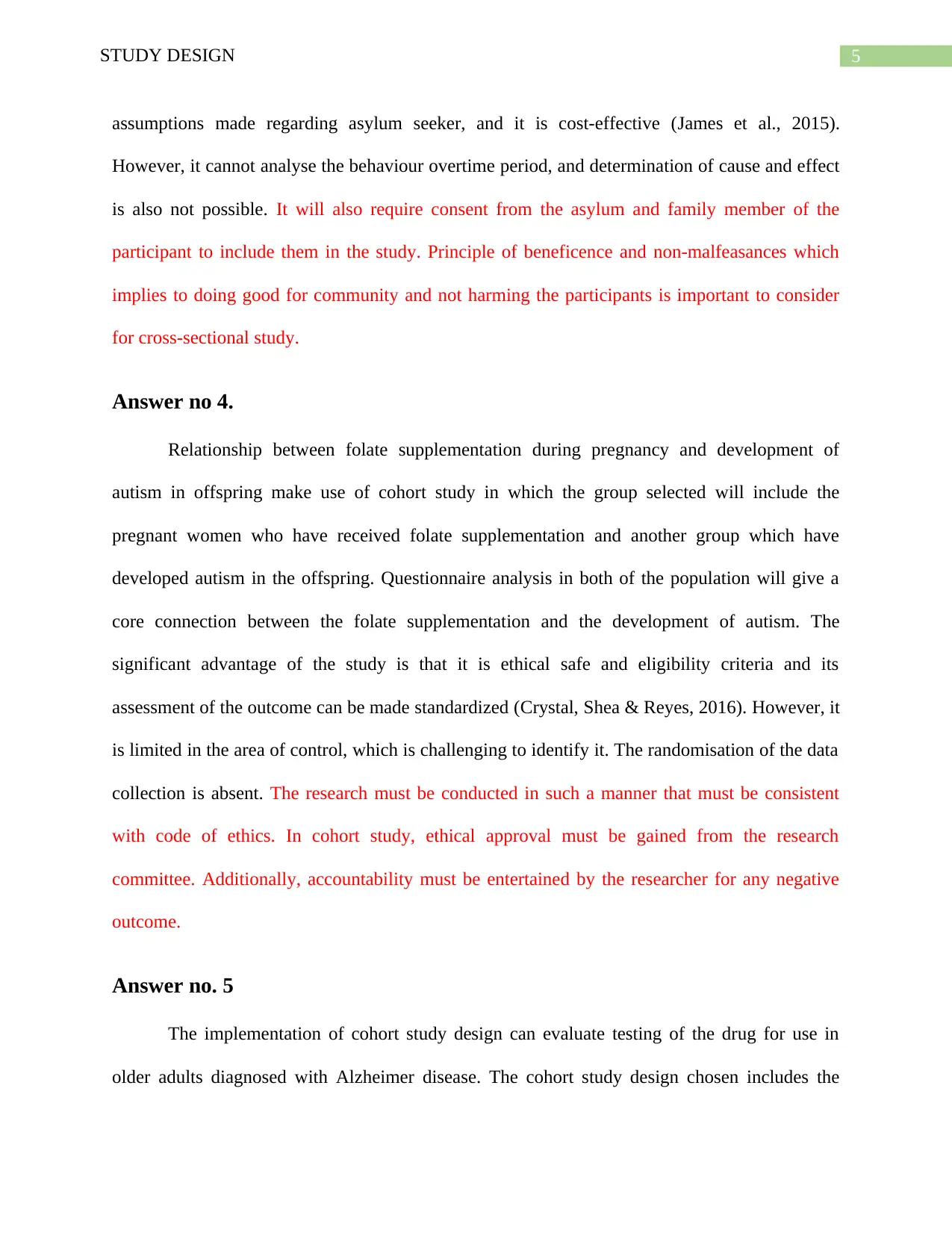
5STUDY DESIGN
assumptions made regarding asylum seeker, and it is cost-effective (James et al., 2015).
However, it cannot analyse the behaviour overtime period, and determination of cause and effect
is also not possible. It will also require consent from the asylum and family member of the
participant to include them in the study. Principle of beneficence and non-malfeasances which
implies to doing good for community and not harming the participants is important to consider
for cross-sectional study.
Answer no 4.
Relationship between folate supplementation during pregnancy and development of
autism in offspring make use of cohort study in which the group selected will include the
pregnant women who have received folate supplementation and another group which have
developed autism in the offspring. Questionnaire analysis in both of the population will give a
core connection between the folate supplementation and the development of autism. The
significant advantage of the study is that it is ethical safe and eligibility criteria and its
assessment of the outcome can be made standardized (Crystal, Shea & Reyes, 2016). However, it
is limited in the area of control, which is challenging to identify it. The randomisation of the data
collection is absent. The research must be conducted in such a manner that must be consistent
with code of ethics. In cohort study, ethical approval must be gained from the research
committee. Additionally, accountability must be entertained by the researcher for any negative
outcome.
Answer no. 5
The implementation of cohort study design can evaluate testing of the drug for use in
older adults diagnosed with Alzheimer disease. The cohort study design chosen includes the
assumptions made regarding asylum seeker, and it is cost-effective (James et al., 2015).
However, it cannot analyse the behaviour overtime period, and determination of cause and effect
is also not possible. It will also require consent from the asylum and family member of the
participant to include them in the study. Principle of beneficence and non-malfeasances which
implies to doing good for community and not harming the participants is important to consider
for cross-sectional study.
Answer no 4.
Relationship between folate supplementation during pregnancy and development of
autism in offspring make use of cohort study in which the group selected will include the
pregnant women who have received folate supplementation and another group which have
developed autism in the offspring. Questionnaire analysis in both of the population will give a
core connection between the folate supplementation and the development of autism. The
significant advantage of the study is that it is ethical safe and eligibility criteria and its
assessment of the outcome can be made standardized (Crystal, Shea & Reyes, 2016). However, it
is limited in the area of control, which is challenging to identify it. The randomisation of the data
collection is absent. The research must be conducted in such a manner that must be consistent
with code of ethics. In cohort study, ethical approval must be gained from the research
committee. Additionally, accountability must be entertained by the researcher for any negative
outcome.
Answer no. 5
The implementation of cohort study design can evaluate testing of the drug for use in
older adults diagnosed with Alzheimer disease. The cohort study design chosen includes the
⊘ This is a preview!⊘
Do you want full access?
Subscribe today to unlock all pages.

Trusted by 1+ million students worldwide
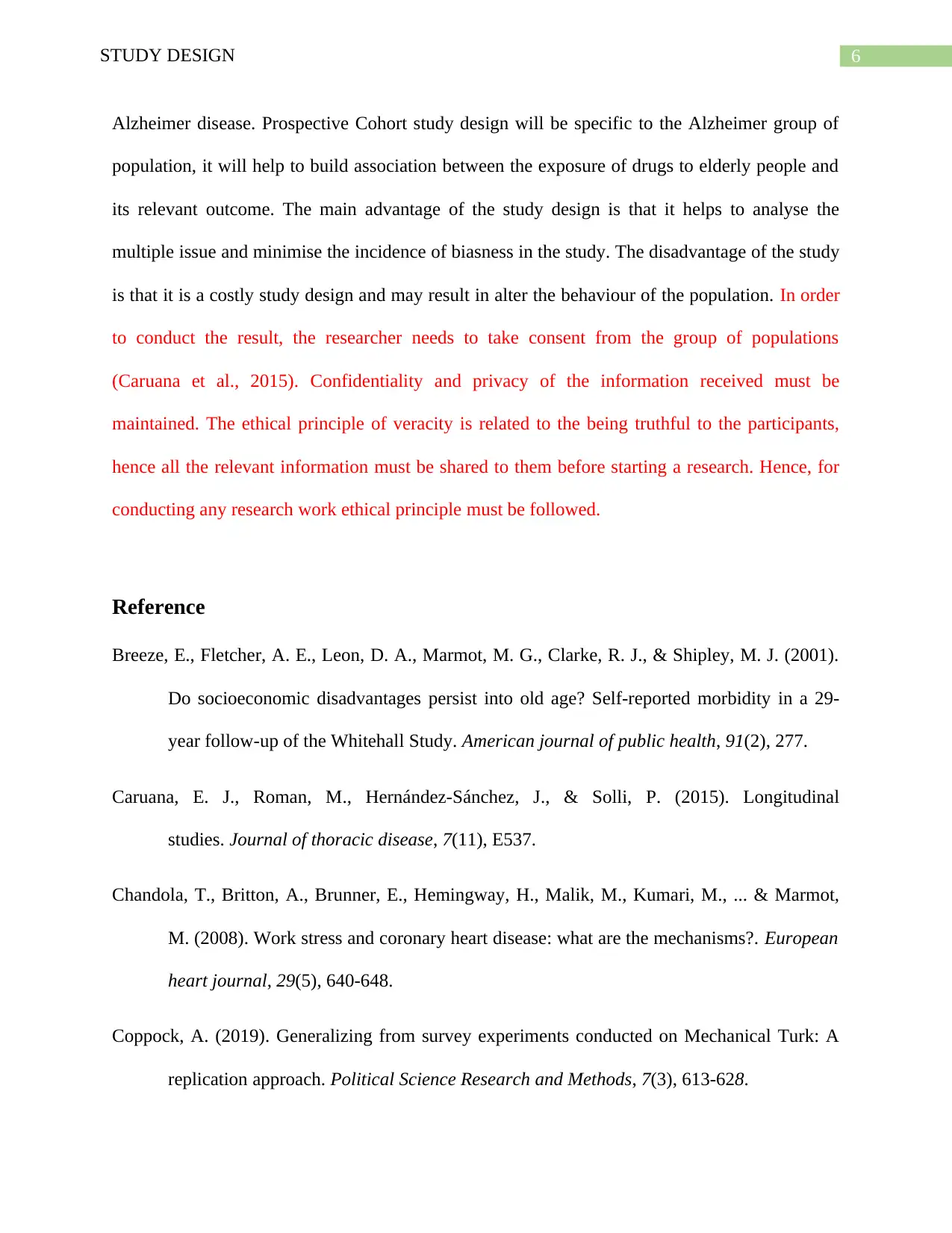
6STUDY DESIGN
Alzheimer disease. Prospective Cohort study design will be specific to the Alzheimer group of
population, it will help to build association between the exposure of drugs to elderly people and
its relevant outcome. The main advantage of the study design is that it helps to analyse the
multiple issue and minimise the incidence of biasness in the study. The disadvantage of the study
is that it is a costly study design and may result in alter the behaviour of the population. In order
to conduct the result, the researcher needs to take consent from the group of populations
(Caruana et al., 2015). Confidentiality and privacy of the information received must be
maintained. The ethical principle of veracity is related to the being truthful to the participants,
hence all the relevant information must be shared to them before starting a research. Hence, for
conducting any research work ethical principle must be followed.
Reference
Breeze, E., Fletcher, A. E., Leon, D. A., Marmot, M. G., Clarke, R. J., & Shipley, M. J. (2001).
Do socioeconomic disadvantages persist into old age? Self-reported morbidity in a 29-
year follow-up of the Whitehall Study. American journal of public health, 91(2), 277.
Caruana, E. J., Roman, M., Hernández-Sánchez, J., & Solli, P. (2015). Longitudinal
studies. Journal of thoracic disease, 7(11), E537.
Chandola, T., Britton, A., Brunner, E., Hemingway, H., Malik, M., Kumari, M., ... & Marmot,
M. (2008). Work stress and coronary heart disease: what are the mechanisms?. European
heart journal, 29(5), 640-648.
Coppock, A. (2019). Generalizing from survey experiments conducted on Mechanical Turk: A
replication approach. Political Science Research and Methods, 7(3), 613-628.
Alzheimer disease. Prospective Cohort study design will be specific to the Alzheimer group of
population, it will help to build association between the exposure of drugs to elderly people and
its relevant outcome. The main advantage of the study design is that it helps to analyse the
multiple issue and minimise the incidence of biasness in the study. The disadvantage of the study
is that it is a costly study design and may result in alter the behaviour of the population. In order
to conduct the result, the researcher needs to take consent from the group of populations
(Caruana et al., 2015). Confidentiality and privacy of the information received must be
maintained. The ethical principle of veracity is related to the being truthful to the participants,
hence all the relevant information must be shared to them before starting a research. Hence, for
conducting any research work ethical principle must be followed.
Reference
Breeze, E., Fletcher, A. E., Leon, D. A., Marmot, M. G., Clarke, R. J., & Shipley, M. J. (2001).
Do socioeconomic disadvantages persist into old age? Self-reported morbidity in a 29-
year follow-up of the Whitehall Study. American journal of public health, 91(2), 277.
Caruana, E. J., Roman, M., Hernández-Sánchez, J., & Solli, P. (2015). Longitudinal
studies. Journal of thoracic disease, 7(11), E537.
Chandola, T., Britton, A., Brunner, E., Hemingway, H., Malik, M., Kumari, M., ... & Marmot,
M. (2008). Work stress and coronary heart disease: what are the mechanisms?. European
heart journal, 29(5), 640-648.
Coppock, A. (2019). Generalizing from survey experiments conducted on Mechanical Turk: A
replication approach. Political Science Research and Methods, 7(3), 613-628.
Paraphrase This Document
Need a fresh take? Get an instant paraphrase of this document with our AI Paraphraser
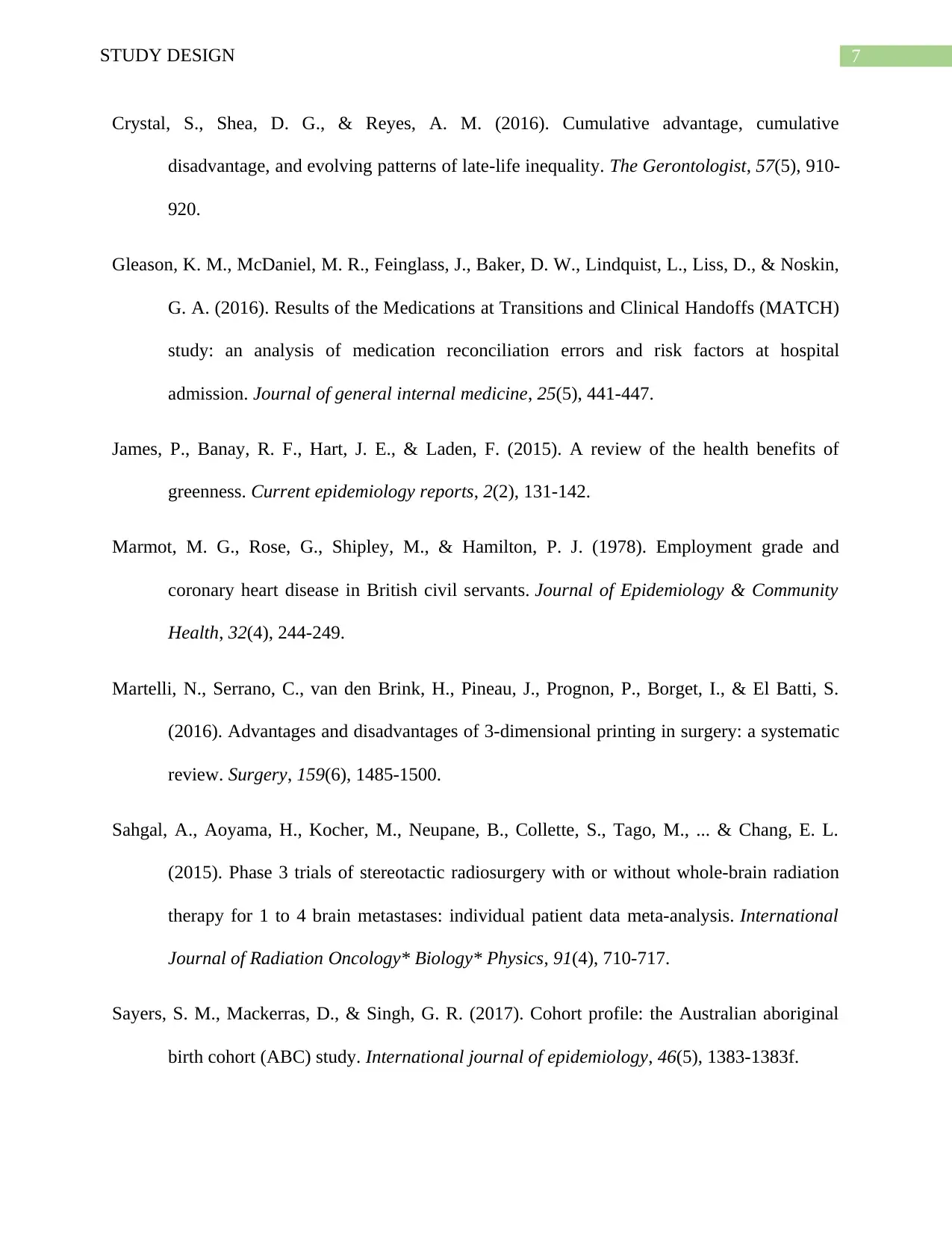
7STUDY DESIGN
Crystal, S., Shea, D. G., & Reyes, A. M. (2016). Cumulative advantage, cumulative
disadvantage, and evolving patterns of late-life inequality. The Gerontologist, 57(5), 910-
920.
Gleason, K. M., McDaniel, M. R., Feinglass, J., Baker, D. W., Lindquist, L., Liss, D., & Noskin,
G. A. (2016). Results of the Medications at Transitions and Clinical Handoffs (MATCH)
study: an analysis of medication reconciliation errors and risk factors at hospital
admission. Journal of general internal medicine, 25(5), 441-447.
James, P., Banay, R. F., Hart, J. E., & Laden, F. (2015). A review of the health benefits of
greenness. Current epidemiology reports, 2(2), 131-142.
Marmot, M. G., Rose, G., Shipley, M., & Hamilton, P. J. (1978). Employment grade and
coronary heart disease in British civil servants. Journal of Epidemiology & Community
Health, 32(4), 244-249.
Martelli, N., Serrano, C., van den Brink, H., Pineau, J., Prognon, P., Borget, I., & El Batti, S.
(2016). Advantages and disadvantages of 3-dimensional printing in surgery: a systematic
review. Surgery, 159(6), 1485-1500.
Sahgal, A., Aoyama, H., Kocher, M., Neupane, B., Collette, S., Tago, M., ... & Chang, E. L.
(2015). Phase 3 trials of stereotactic radiosurgery with or without whole-brain radiation
therapy for 1 to 4 brain metastases: individual patient data meta-analysis. International
Journal of Radiation Oncology* Biology* Physics, 91(4), 710-717.
Sayers, S. M., Mackerras, D., & Singh, G. R. (2017). Cohort profile: the Australian aboriginal
birth cohort (ABC) study. International journal of epidemiology, 46(5), 1383-1383f.
Crystal, S., Shea, D. G., & Reyes, A. M. (2016). Cumulative advantage, cumulative
disadvantage, and evolving patterns of late-life inequality. The Gerontologist, 57(5), 910-
920.
Gleason, K. M., McDaniel, M. R., Feinglass, J., Baker, D. W., Lindquist, L., Liss, D., & Noskin,
G. A. (2016). Results of the Medications at Transitions and Clinical Handoffs (MATCH)
study: an analysis of medication reconciliation errors and risk factors at hospital
admission. Journal of general internal medicine, 25(5), 441-447.
James, P., Banay, R. F., Hart, J. E., & Laden, F. (2015). A review of the health benefits of
greenness. Current epidemiology reports, 2(2), 131-142.
Marmot, M. G., Rose, G., Shipley, M., & Hamilton, P. J. (1978). Employment grade and
coronary heart disease in British civil servants. Journal of Epidemiology & Community
Health, 32(4), 244-249.
Martelli, N., Serrano, C., van den Brink, H., Pineau, J., Prognon, P., Borget, I., & El Batti, S.
(2016). Advantages and disadvantages of 3-dimensional printing in surgery: a systematic
review. Surgery, 159(6), 1485-1500.
Sahgal, A., Aoyama, H., Kocher, M., Neupane, B., Collette, S., Tago, M., ... & Chang, E. L.
(2015). Phase 3 trials of stereotactic radiosurgery with or without whole-brain radiation
therapy for 1 to 4 brain metastases: individual patient data meta-analysis. International
Journal of Radiation Oncology* Biology* Physics, 91(4), 710-717.
Sayers, S. M., Mackerras, D., & Singh, G. R. (2017). Cohort profile: the Australian aboriginal
birth cohort (ABC) study. International journal of epidemiology, 46(5), 1383-1383f.

8STUDY DESIGN
Tetnowski, J. (2015). Qualitative case study research design. Perspectives on Fluency and
Fluency Disorders, 25(1), 39-45.
Tetnowski, J. (2015). Qualitative case study research design. Perspectives on Fluency and
Fluency Disorders, 25(1), 39-45.
⊘ This is a preview!⊘
Do you want full access?
Subscribe today to unlock all pages.

Trusted by 1+ million students worldwide
1 out of 9
Related Documents
Your All-in-One AI-Powered Toolkit for Academic Success.
+13062052269
info@desklib.com
Available 24*7 on WhatsApp / Email
![[object Object]](/_next/static/media/star-bottom.7253800d.svg)
Unlock your academic potential
Copyright © 2020–2025 A2Z Services. All Rights Reserved. Developed and managed by ZUCOL.




